Fêtes galantes
Year: 1942
Author: Paul Verlaine (1844 - 1896)
Artist: André Dignimont (1891 - 1965)
Publisher: Creuzevault
Charming illustrations
The poems of Fêtes galantes lend themselves to charming illustrations in the 18th-century gallant style. Editions of this work in the Koopman Collection were illustrated by George Barbier, Serge de Solomko, A. Calbet, Marie Laurencin and André Dignimont. Dignimont began as a painter of landscapes, nudes and portraits. He exhibited his work in the Araignée Salon (founded by illustrator Gus Bofa), and dedicated himself increasingly to the art of illustration. For this edition of Verlaine, Dignimont's drawings have been reproduced by Georges Beltrand and coloured by Edmond Vairel. The pastel colours correspond closely to the gallant scenes. The illustrations of circa 9 by 8 centimetres mostly show landscapes: parks, forests, caves, lanes, gardens and ponds. The human figures fade away into nothingness: the figures in their 18th-century costumes are only one centimetre tall. Their faces have no recognizable features; they are mostly empty ovals, without eyes, nose or mouth. The masquerade fits Verlaine's themes closely. The edition appeared in 450 copies, of which this copy (number 142) was bound in half-leather by E. Schroth of Basel.
The innovation in Verlaine's poetry is mostly to be found in his eccentric use of rhythm. His poetry did not excel in profound psychology or shocking images, but in the musicality of his language and in the suggestions he evoked. Although his innovative language rhythms have contributed to the development of free verse, Verlaine has always maintained rhyme. 'De la musique avant toute chose', was the way he phrased it in his Art poétique. His work was strongly admired in the Netherlands, and in the magazine of the youngest generation of that time, De nieuwe gids (‘The new guide’), Willem Kloos devoted warm words to it. J.N. van Hall had done the same thing earlier for the elder generation, in De gids (‘The guide’). Publisher J. Blok (Maison Blok) in The Hague invited Verlaine to hold lectures on French poetry, an invitation that Verlaine accepted gladly due to the generous wages.
Two weeks in the Netherlands
In November 1892 Verlaine visited The Hague, Leiden, Amsterdam, and finally The Hague again. Verlaine's voice was so soft that some listeners couldn't hear what he had to say about the Parnassiens, but the guest was so famous that it was already a pleasure to see him in person. Verlaine said very little about the kind of poetry that he championed. He mostly read the verses of fellow poets along with some work of his own. He read his own work best, and it received a great deal of support. It was followed by a dinner at which the most famous Dutch poet of that period was seated opposite his French peer, which became the source of many anecdotes. Willem Kloos and Paul Verlaine never engaged in animated literary conversation. Little more was said than 'Monsieur Klooze, aimez-vous la salade?' Verlaine's visit left traces in the memoirs of many Dutch authors. Verlaine's own memories of the event faded almost immediately. He did write a booklet about it on request, Quinze jours en Hollande ('Two weeks in the Netherlands'), but in order to do that, he first had to ask his hosts what had actually happened, and he ended up describing events that had never actually taken place, such as a visit to the Mauritshuis.
Bibliographical description
Description: Fêtes galantes / Paul Verlaine ; ill. de Dignimont. - Paris : Creuzevault, 1942. - [45] p. : ill. ; 25 cm
Printer: Marthe Fequet et Pierre Baudier (Paris) (text) Georges Beltrand (wood engravings)
Edition: 549 copies
This copy: Number 142 of 450 on Rives
Notes: Signed with the publisher's initials
Binder: E. Schroth (Bazel)
Bibliography: Carteret IV-393 ; Monod-11095
Shelfmark: KW Koopm L 129
References
- Alain Buisine, Paul Verlaine, histoire d’un corps. Paris, Tallandier, 1995
- Jaap Harskamp, Biecht & ballingschap: Het Nederlandse beeld van Verlaine 1890-1940. Amsterdam, De profundis, 1996
- Paul Verlaine, Correspondance et documents inédits relatifs à son livre 'Quinze jours en Hollande'. La Haye, Maison Blok; Paris, Floury, 1897
- Paul Verlaine, Een droom vreemd en indringend. Amsterdam, Van Oorschot, 2002
- Paul Verlaine, Quinze jours en Hollande: Letttres à un ami. La Haye, Maison Blok; Paris, Vanier, 1893
- Paul Verlaine, Twee weken in Holland: Brieven aan een vriend. Vianen, Kwadraat, 1985
- Louis Vis, 'Verlaine in Nederland', in: La France aux Pays-Bas: Invloeden in het verleden. Vianen, Kwadraat, 1985, p. 154-199
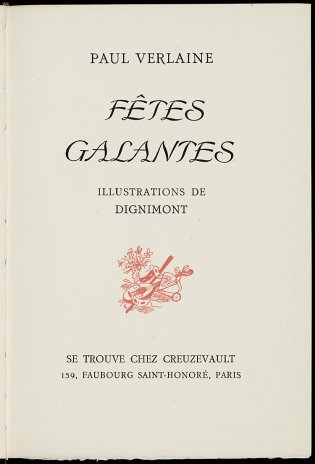
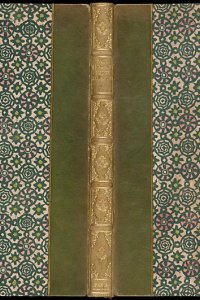
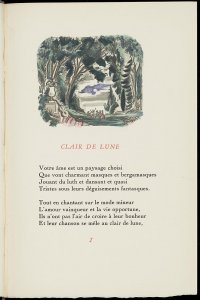
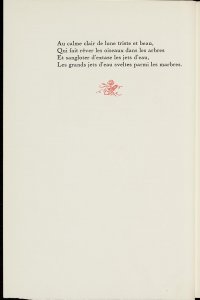
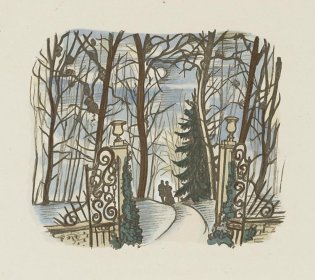
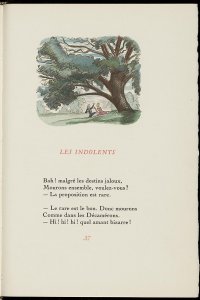
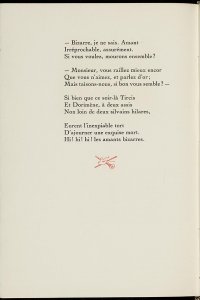
![Colofon met paraaf van Creuzevault (p. [51])](/sites/default/files/styles/galerie/public/images/fetes-galantes-p51.jpg?h=ca0f9a0b&itok=EW8NS3ip)